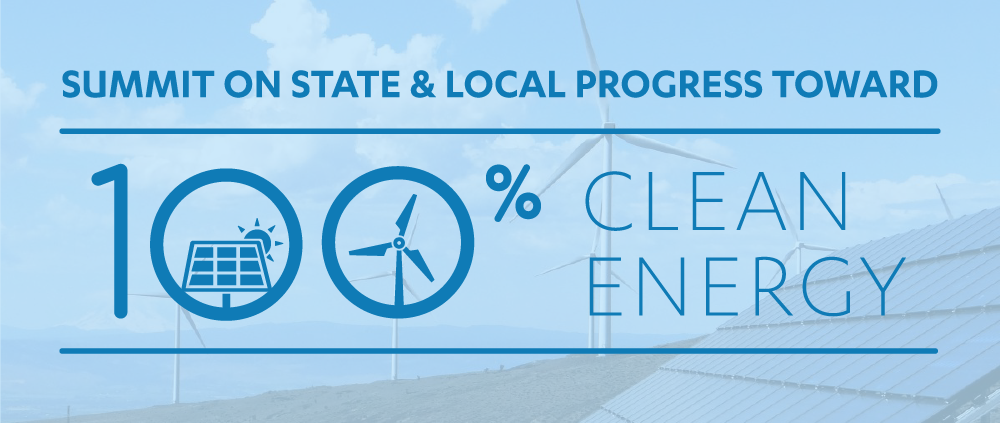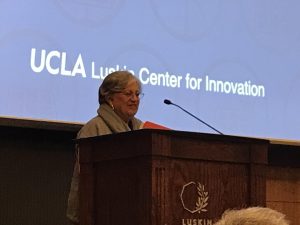

Mary Nicolas, Chairwoman of the California Air Resources Board, at UCLA’s “Summit on State and Local Progress Toward 100% Clean Energy
Inspired. The antidote to my Dubai sentiments! A conference hosted by the Luskin Center for Innovation at the University of California at Los Angeles (UCLA)… a “Summit on State and Local Progress Toward 100% Clean Energy. All environmental pursuits have started at the local level; the summit underscored the power of sub-nationals in the pursuit of climate protection.
This it was. Proof that the path to 100% clean power is not only attainable but being attained. Two speakers pointed out that one in every three Americans lives in a city, county, or state that has committed to 100% clean energy. The race is on! JR DeShazo, Luskin’s director, stated that more than 200 cities and counties across the United States have committed to 100% clean energy goals. More than 70, counties, cities, and towns have achieved this target already. Seven states, led by Hawaii and catalyzed by California, now have pledged 100% green… all in the past 24 months.
California Energy Commission Chairman David Hochschild compared the year 2019 to the 1849 Gold Rush, both defining years in California history. Passed in 2018, SB 100 went into effect in 2019 requiring 100% clean energy by 2045 in California. Meanwhile coal generation has dropped nationally from 52 – 24%, and big coal companies’ value has dropped 99%. At the same time, solar costs have dropped from 50 cents/kWh to less than 2! We’ve tripled renewable power in California in a decade while the GDP has grown by 46%, versus 35% for the rest of the nation. There are five times as many jobs in solar than work at all the states utilities, five times as many as work in solar than do in fossil fuels.
California’s leaders were on hand to discuss how they’d won battles in the legislature. Discussed was the passage of AB 32, the Global Warming Solutions Act of 2006. It put California on the world stage as a climate leader. Its implementation was nothing short of spectacular: Chief implementer, Mary Nichols of the California Air Resources Board, said she was proud that California achieved its goal of cutting emissions to 1990 level s by 2020 four years early. The passage of the low carbon transportation fuel standards was pivotal. And now SB 100… its author Kevin De Leon was in the house and was lauded for his accomplishments.
Nichols made clear that California’s wildfires are now identified with global warming: “They put immediacy to the task; they remind everybody why we’re doing it…. Being radical in the face of crisis is being a realist,” she stated. AB 32’s goals have been achieved. “This gives us standing.” Power sector emissions were cut in half from 2000 to 2016. In California this year, more than half of all generation was sourced from non-fossil fueled sources. “This has been the most ambitious clean-up of the power sector that’s ever been attempted.”
Impressed I was that the invitation-only conference drew participants from 30 states, from Hawaii to Alaska to Washington, DC. The mayor of Salt Lake City (the 16th U.S. city to commit to 100%) talked about her push to 100%, made possible by gross concerns about air quality. (This reminded me of Michael Peevey’s book—California Goes Green — and how pollution catalyzed California’s preeminence in environmental reforms.) Gael Tarleton, legislator from the State of Washington, discussed her state’s path to 100% for electricity, relatively easy for a state that relies largely on hydropower, and whose electricity emissions are 23% of the total. Representative Patricia Roybal Caballero from New Mexico talked recanted the progression of her state’s passage of the Energy Transition Act… also calling for 100% clean electricity in arguably the nation’s poorest state.
JR DeShazo presented great data on the rise of Community Choice Aggregators (CCAs). While investor-owned utilities are constrained by regulation, CCAs now provide consumers the power to choose. Fully 64 CCAs across the country already deliver 100% clean energy. Seven of them do not rely at all on the purchase of Renewable Energy Certificates (RECs) to meet 100%. And how quickly CCAS have risen: In 2011, Marin Clean Energy was formed. Now there are 19 CCAs in California, “buying clubs” representing some 160 cities and counties.
The former mayor of Greensburg, Kansas – Bob Dixson — struck me with his good old-fashioned common sense. His town was destroyed in 2007 by a tornado, 205 mile per hour winds two miles wide. In addition to deaths, fully 95% of the town’s structures were lost. Far from lamenting, Greensburg residents were “blessed with the opportunity to rebuild.” And they rebuilt green. Thanks to efficiency, Greensburg cut power consumption per capita by 40% and water use by 50%. Now the town is entirely powered by the wind and power rates have been stable for 14 years.
What struck me most about Dixson’s remarks related to politics: “We don’t do R&D here,” he said. That’s Republicans and Democrats. Each of us needs to make a difference, transcend ideology, and cut consumption. Dixson said that we don’t need to talk about how green or sustainable we are… but how to endure for a lifetime. And in Greenburg, front porches came back… a means for neighbors to be neighbors, to build trust in different viewpoints, and to dialogue on issues like climate change.
